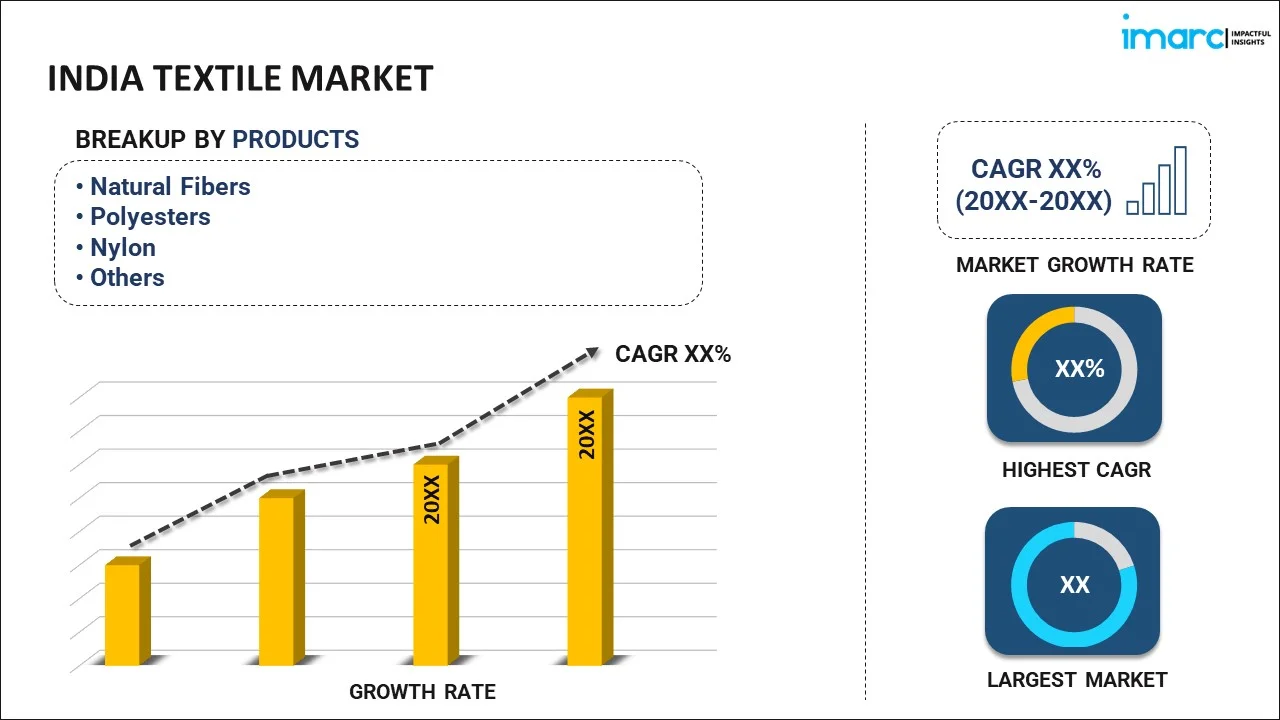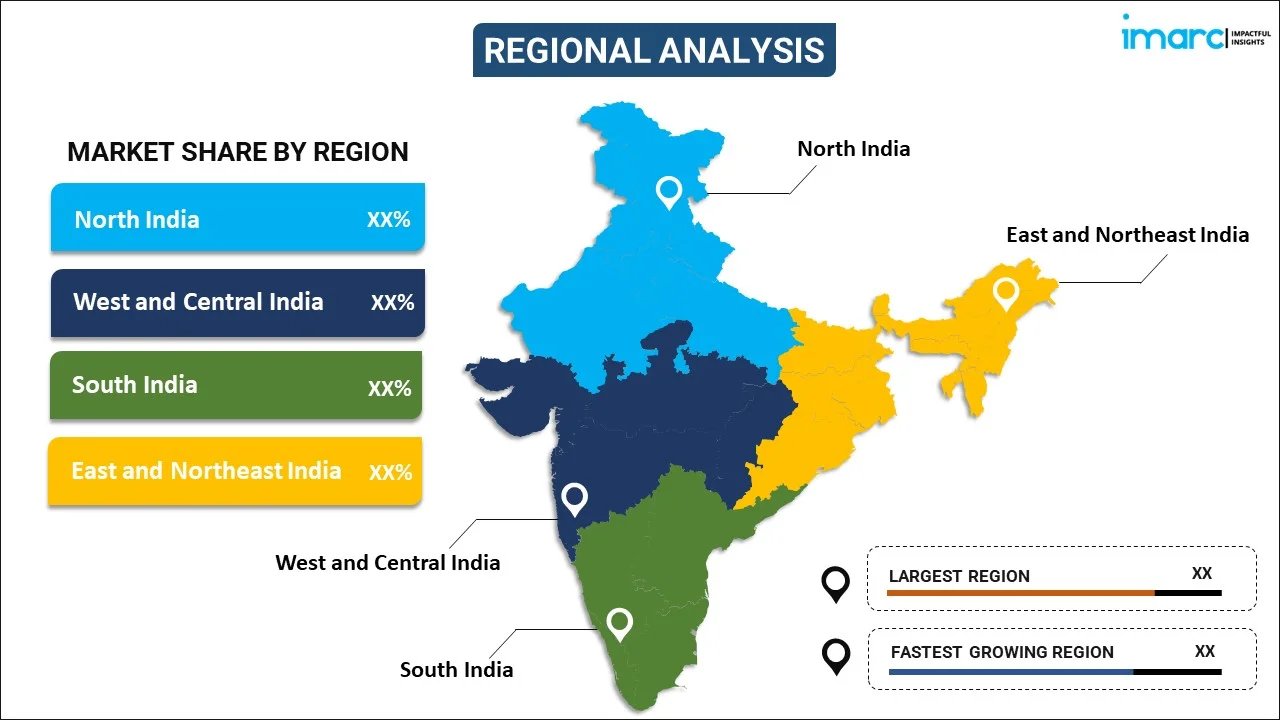
India Textile Market Report by Product (Natural Fibers, Polyesters, Nylon, and Others), Raw Material (Cotton, Chemical, Wool, Silk, and Others), Application (Household, Technical, Fashion and Clothing, and Others), and Region 2025-2033
Market Overview:
India textile market size reached USD 146.6 Billion in 2024. Looking forward, IMARC Group expects the market to reach USD 213.5 Billion by 2033, exhibiting a growth rate (CAGR) of 3.85% during 2025-2033. The increasing trends in fashion, home decor, and lifestyle choices, which directly impact the types and quantities of textiles produced, are driving the market.
|
Report Attribute
|
Key Statistics
|
|---|---|
|
Base Year
|
2024 |
|
Forecast Years
|
2025-2033 |
|
Historical Years
|
2019-2024
|
| Market Size in 2024 | USD 146.6 Billion |
| Market Forecast in 2033 | USD 213.5 Billion |
| Market Growth Rate (2025-2033) | 3.85% |
Textiles are an integral part of human civilization, serving as a cornerstone of cultural identity, fashion, and daily life. The textile industry encompasses the production of fabrics and materials through various processes, including spinning, weaving, and dyeing. From ancient civilizations' rudimentary looms to modern automated factories, textiles have evolved in both form and function. Fabrics range from natural fibers like cotton and wool to synthetic materials such as polyester and nylon, each offering unique characteristics and applications. Textiles play a pivotal role in fashion, interior design, and industrial applications, contributing significantly to economies. The industry's innovations include sustainable practices, advanced technologies, and smart textiles that integrate electronic components. As the textile sector continues to adapt to changing demands and environmental concerns, its rich history and ongoing evolution highlight its enduring significance in the interconnected world.
India Textile Market Trends:
The textile market in India is propelled by various key drivers that collectively contribute to its dynamic growth. Firstly, the rising regional population and increasing disposable incomes have fueled the demand for clothing and textiles, acting as primary catalysts for market expansion. Additionally, shifting consumer preferences towards sustainable and eco-friendly fabrics have emerged as a significant driving force. As environmental awareness grows, there is an increasing demand for textiles produced through eco-conscious methods, thereby influencing market trends. Moreover, technological advancements in the textile industry play a pivotal role in shaping market dynamics. Innovations in manufacturing processes, such as the development of smart textiles and advanced materials, have garnered substantial attention and significantly impacted market growth. Furthermore, the expansion of e-commerce platforms has facilitated easier access to a diverse range of textiles, fostering market growth regionally. Besides this, the textile market is intricately connected to fashion trends, and the ever-changing nature of consumer preferences and style preferences acts as a perpetual driver. The interconnected nature of these factors establishes a resilient and adaptable textile market, constantly evolving to meet the demands of a dynamic regional consumer base. In conclusion, the textile market in India is driven by a confluence of demographic, environmental, technological, and fashion-related factors, collectively steering the industry towards sustained growth.
India Textile Market Segmentation:
IMARC Group provides an analysis of the key trends in each segment of the market, along with forecasts at the country level for 2025-2033. Our report has categorized the market based on product, raw material, and application.
Product Insights:

- Natural Fibers
- Polyesters
- Nylon
- Others
The report has provided a detailed breakup and analysis of the market based on the product. This includes natural fibers, polyesters, nylon, and others.
Raw Material Insights:
- Cotton
- Chemical
- Wool
- Silk
- Others
A detailed breakup and analysis of the market based on the raw material have also been provided in the report. This includes cotton, chemical, wool, silk, and others.
Application Insights:
- Household
- Technical
- Fashion and Clothing
- Others
The report has provided a detailed breakup and analysis of the market based on the application. This includes household, technical, fashion and clothing, and others.
Regional Insights:

- North India
- West and Central India
- South India
- East and Northeast India
The report has also provided a comprehensive analysis of all the major regional markets, which include North India, West and Central India, South India, and East and Northeast India.
Competitive Landscape:
The market research report has also provided a comprehensive analysis of the competitive landscape in the market. Competitive analysis such as market structure, key player positioning, top winning strategies, competitive dashboard, and company evaluation quadrant has been covered in the report. Also, detailed profiles of all major companies have been provided.
India Textile Market Report Coverage:
| Report Features | Details |
|---|---|
| Base Year of the Analysis | 2024 |
| Historical Period | 2019-2024 |
| Forecast Period | 2025-2033 |
| Units | Billion USD |
| Scope of the Report | Exploration of Historical Trends and Market Outlook, Industry Catalysts and Challenges, Segment-Wise Historical and Future Market Assessment:
|
| Products Covered | Natural Fibers, Polyesters, Nylon, Others |
| Raw Materials Covered | Cotton, Chemical, Wool, Silk, Others |
| Applications Covered | Household, Technical, Fashion and Clothing, Others |
| Regions Covered | North India, West and Central India, South India, East and Northeast India |
| Customization Scope | 10% Free Customization |
| Post-Sale Analyst Support | 10-12 Weeks |
| Delivery Format | PDF and Excel through Email (We can also provide the editable version of the report in PPT/Word format on special request) |
Key Questions Answered in This Report:
- How has the India textile market performed so far and how will it perform in the coming years?
- What has been the impact of COVID-19 on the India textile market?
- What is the breakup of the India textile market on the basis of product?
- What is the breakup of the India textile market on the basis of raw material?
- What is the breakup of the India textile market on the basis of application?
- What are the various stages in the value chain of the India textile market?
- What are the key driving factors and challenges in the India textile?
- What is the structure of the India textile market and who are the key players?
- What is the degree of competition in the India textile market?
Key Benefits for Stakeholders:
- IMARC’s industry report offers a comprehensive quantitative analysis of various market segments, historical and current market trends, market forecasts, and dynamics of the India textile market from 2019-2033.
- The research report provides the latest information on the market drivers, challenges, and opportunities in the India textile market.
- Porter's five forces analysis assist stakeholders in assessing the impact of new entrants, competitive rivalry, supplier power, buyer power, and the threat of substitution. It helps stakeholders to analyze the level of competition within the India textile industry and its attractiveness.
- Competitive landscape allows stakeholders to understand their competitive environment and provides an insight into the current positions of key players in the market.
Need more help?
- Speak to our experienced analysts for insights on the current market scenarios.
- Include additional segments and countries to customize the report as per your requirement.
- Gain an unparalleled competitive advantage in your domain by understanding how to utilize the report and positively impacting your operations and revenue.
- For further assistance, please connect with our analysts.
 Inquire Before Buying
Inquire Before Buying
 Speak to an Analyst
Speak to an Analyst
 Request Brochure
Request Brochure
 Request Customization
Request Customization




.webp)




.webp)












